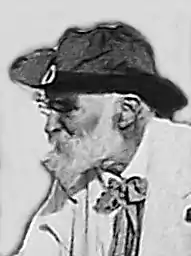Charles Seignobos | |
|---|---|
 | |
| Born | 10 September 1854 Lamastre, Ardèche |
| Died | 24 April 1942 (aged 87) Ploubazlanec |
| Occupation | Historian |
| Nationality | French |
| Subject | History |
| Literary movement | Historical method |
Charles Seignobos (10 September 1854 – 24 April 1942) was a French scholar of historiography and a historian who specialized in the history of the French Third Republic, and was a member of the Human Rights League.
Personal life and education
Seignobos was born to a Republican Protestant family in 1854 at Lamastre in the Ardèche department of France, the son of Charles-André Seignobos, the deputy for Ardèche from 1871 to 1881 and again from 1890 to 1892 and also the Councillor of Lamastre from 1852–1892. He passed his baccalaureat in 1871 at Tournon, where he studied with the French Symbolist poet and critic Stéphane Mallarmé.[1] After a stellar academic career at the École normale supérieure where he took courses with Numa Denis Fustel de Coulanges and Ernest Lavisse, he completed a degree in history.
Afterwards, he moved to Germany where he studied for two years, spending most of his time in Göttingen, Berlin, Munich, and Leipzig. Named to a tenured position as Maître de conférences at the University of Burgundy in 1879 and a professor at the Écoles des hautes études internationales et politiques (HEI-HEP), he defended his doctoral thesis in 1881, and then was named to a position at the Sorbonne. He is regarded, along with his friend the physiologist Louis Lapicque, as one of the two founders of the scientific and humanistic community "Sorbonne-Plage" at L'Arcouest in Ploubazlanec, near Paimpol. (Marie Curie had a house constructed there and moved there in 1912).[2][3]
His brother Raymond Seignobos succeeded their father (who had been a mayor for just a few weeks in 1870) as Mayor of Lamastre from 1895 to 1914.
Charles Seignobos died in April 1942 after having been placed under house arrest at Ploubazlanec in Brittany.
Career
Considered along with Charles-Victor Langlois as one of the leading proponents of the historical method, Seignobos wrote a number of works on political history which implemented the German Historical_method, benefiting from his excellent knowledge of linguistic particulars in documentary research in English and German. He is, as a result of his critical reading of manuscripts, regarded as one of the major figures in the history of the historical method.
To emphasize the importance of primary sources, Seignobos and Langlois began their book "L'Introduction aux études historiques" (1898) with their famous maxim, "History is made with documents."[4][5]
Notes and references
- ↑ Mallarmé, Correspondance, Folio Classique, 1995, p. 189.
- ↑ Sorbonne-Plage. Les Curie et les Joliot : des savants sur la côte bretonne (1900-1950) [archive], présentation de l'exposition de la BNF.
- ↑ Hervé Queillé, L'Arcouest. Les héritiers de Sorbonne-Plage 16 août 2013 [archive] sur le site du Télégramme (consulté le 7 février 2015).
- ↑ den Boer, Pim (14 July 2014). History as a Profession: The Study of History in France, 1818-1914. Princeton University Press. pp. 298–. ISBN 978-1-4008-6484-3. OCLC 1013963347.
'History is made with documents.'
- ↑ Langlois, Charles Victor (1898). Introduction to the Study of History. H. Holt. pp. 1–. ISBN 978-0-7905-5364-1. OCLC 150572322.
L'histoire se fait avec des documents. Les documents sont les traces qu'ont laissées les pensées et les actes des hommes d'autrefois.
[History is made with documents. Documents are the traces left by the thoughts and actions of people from times past.]
External links
 Media related to Charles Seignobos at Wikimedia Commons
Media related to Charles Seignobos at Wikimedia Commons Works by or about Charles Seignobos at Wikisource
Works by or about Charles Seignobos at Wikisource- Works by Charles Seignobos at Project Gutenberg